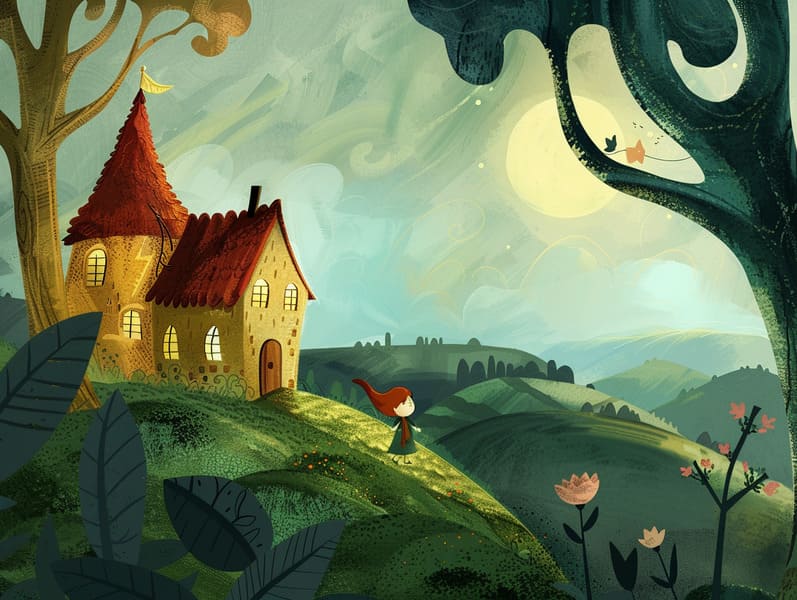
Best fairy tales have timeless appeal. These narratives have been whispered from one generation to the next far before they were ever recorded. They arose from a variety of backgrounds, including American traditions. They were initially disseminated among older generations, often carrying themes and messages reflective of the societal norms and beliefs of the time.
The Grimm brothers, Jacob and Wilhelm (the Grimm brothers), were among the first to gather many of these beloved fairy tales. Their compilation, "Grimm's Fairy Stories," included narratives like "The Little Glass Slipper," "The Story of Hansel and Gretel," and "Little Snow White," which have since become classics in the world of timeless fairy tales. Similarly, Hans Christian Andersen's whimsical stories, such as "The Story of the Little Mermaid," and "The Little Duckling," have won hearts worldwide, solidifying their place in the pantheon of beloved fairy tales.
Despite being ancient, traditional fairy tales remain as pertinent as ever, especially as bedtime stories for kids. These enchanting tales are now available in numerous formats, including gorgeously illustrated books, fantastical animations, and free fairy tales online.
Their lasting appeal can be linked to several delightful features:
Life Lessons: Ancient fairy tales often convey important moral lessons. Tales like "The Boy Who Cried Wolf" teach the value of truthfulness, while "The Race of the Tortoise and the Hare" demonstrate the merits of steadfastness and humbleness. These narratives offer young readers clear distinctions between correct and incorrect, forming their moral compass in a gentle yet lasting way.
Sympathy and Perception: Classic fairy tales frequently showcase heroines facing challenges and problems, inciting young readers to resonate with their struggles and cheer for their triumphs. For instance, "Beauty's Beast" points out the value of seeing inner beauty to acknowledge the inner self of a person, strengthening kindness and discernment.
Cultural Comprehension: Many ancient fairy tales are rooted in the cultural contexts from which they emerged. Exploring these stories can provide enlightening views into different customs, nurturing a sense of cultural awareness and understanding.
Inventiveness and Fantasy: The mythical elements in fairy tales—enchanted objects—boost children’s dreaming abilities. These stories lead readers to imaginary realms, motivating inventive ideas and a sense of delight that persists a lifetime.
Old fairy tales are not only delightful but also pedagogical. They function as bewitching tools in enhancing various intellectual and emotional capacities in children. When ancient fairy tales are narrated, they foster speaking abilities by showing new lexicon and detailed sentence structures. This practice also improves hearing abilities and attention span, as kids stay focused, keen to see what happens next.
Furthermore, exploring the themes and characters of timeless fairy tales can cultivate logical thinking and analytical skills. Kids are instructed to see patterns, guess what will happen, and know cause and effect. These debates also facilitate little ones express get more info their thoughts and feelings, strengthening their emotional intelligence.
In today’s electronic age, the existence of online fairy tales has made these tales more reachable than ever. Web platforms and digital apps provide huge assortments of popular fairy tales that can be experienced or listened to anytime, anywhere. Fairy tales read aloud are particularly prevalent, offering an delightful method for young ones to savor these delightful tales. Read-aloud books and read-aloud videos lead characters and settings to life, often supplemented by enchanting soundtracks and soundtracks that elevate the storytelling experience.
The lasting appeal of traditional fairy tales lies in their ability to transform to modern times while continuing with their key morals. Contemporary versions of these narratives often showcase more different characters and modern settings, making them relatable to today’s audience. However, the fundamental themes of boldness, kindness, and lawfulness remain unchanged, continuing to touch young readers of all ages.
Fairy tales also offer a sense of reassurance and understanding. They share a neat narrative with a obvious beginning, middle, and end, often closing with the termination of conflicts and the triumph of goodness over badness. This predictability can be reassuring for kids, affording a sense of security in an ever-changing world.
Classic fairy tales continue to fascinate and inform new generations, maintaining their appeal and significance in modern society. As children's bedtime stories, they disclose a perfect blend of wonder and wisdom, nurturing moral values, empathy, and creativity. The presence of online fairy tales and the popularity of fairy tales recited promise that these ancient tales remain obtainable to new generations.
By defending and passing on these narratives, we continue to glorify the rich tapestry of cultural heritage and cultural heritage. Whether you are accessing a artistically illustrated book, perusing a online library, or playing an read-aloud book, the spell of traditional fairy tales is always within reach. These narratives emphasize of the perpetual force of stories and its ability to link us across epochs and places.
Even if you are enjoying a gorgeously illustrated book, browsing a electronic collection, or listening to an sound book, the appeal of bedtime fairy tales is always within reach.
These fairy tales show us of the undying presence of storytelling and its ability to join us across eras and regions, creating a bond that fascinates and enlightens alike.